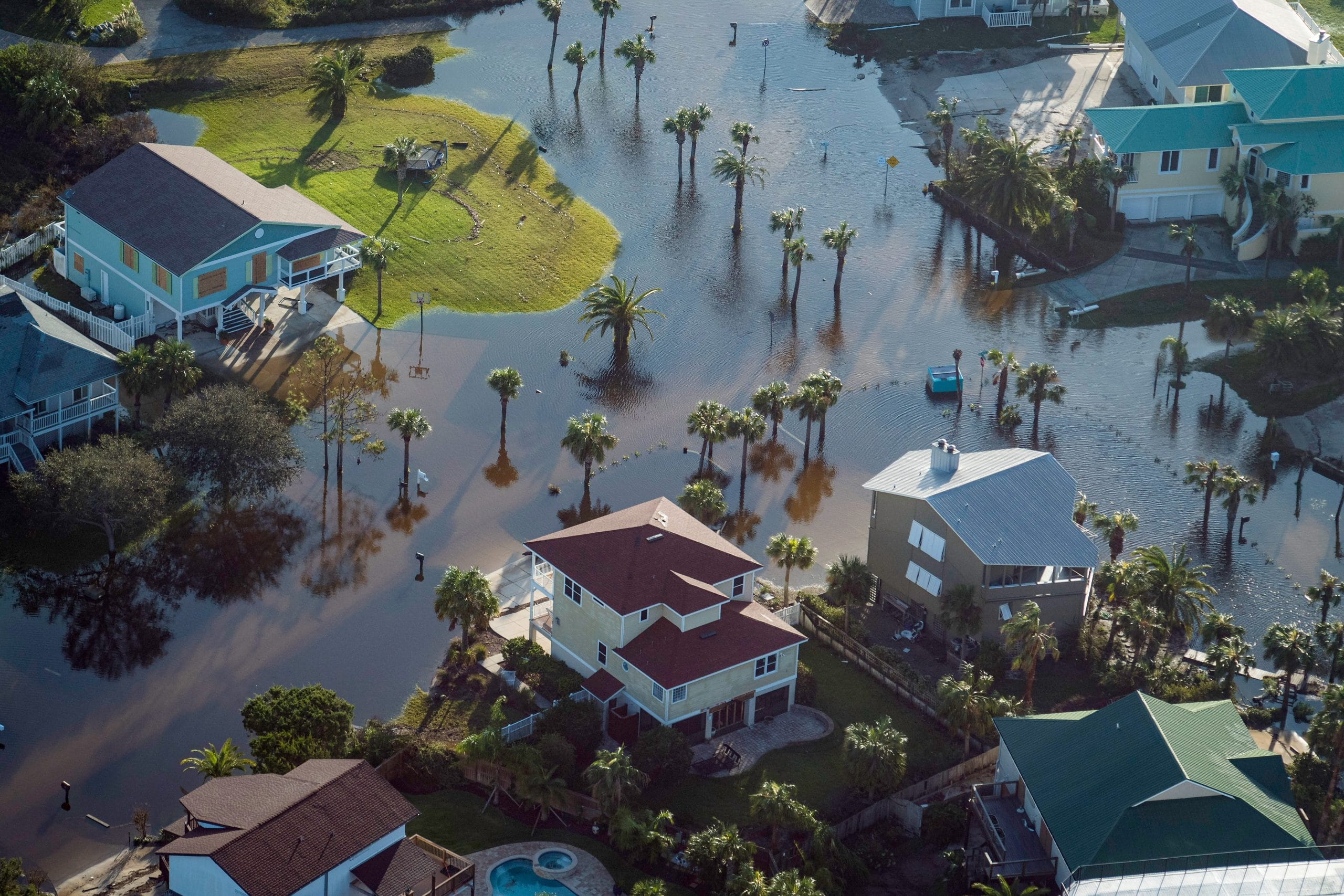Step into a historical storm zone as we unveil the gripping tale of St. Augustine, Florida, a vibrant coastal jewel that’s faced the furious wrath of countless hurricanes over the years. From the first recorded storm in 1565 to the devastating ones that tested the city’s limits, this engrossing narrative takes you on a captivating journey through time, revealing the indomitable spirit of a community that has weathered the tempestuous storms that shaped their destiny.
History of Hurricanes in St. Augustine, Florida
St. Augustine, Florida, a city steeped in history, has a deep and sometimes tumultuous relationship with hurricanes. Since its founding, these powerful storms have left their mark on the city’s landscape and its very story.
Let’s travel back to the 16th century. In 1565, a powerful hurricane swept through the region, forever altering the course of history. This storm is believed to have played a crucial role in helping Pedro Menendez de Avilés secure a Spanish foothold in Florida. The hurricane decimated a French fleet, effectively ending their challenge for control of the area. This event alone reveals how intertwined the city’s fate is with the raw power of hurricanes.
Just a few decades later, in 1599, another ferocious hurricane slammed into St. Augustine, leaving a trail of devastation in its wake. The fledgling town, still finding its footing, was dealt a severe blow, demonstrating the awesome and sometimes unforgiving power of nature.
Centuries later, the “Hurricane of 1811” roared ashore, leaving an enduring mark on the city. This storm dramatically reshaped the St. Augustine coastline, with its impact still visible today. For example, property deeds from the 1820s on Marine Street reflect the hurricane’s damage, showcasing how these events have shaped the very fabric of the city’s development.
These are just a few examples of how hurricanes have shaped St. Augustine’s journey. The city’s resilience in the face of these storms speaks volumes. Time and again, St. Augustine has picked itself up, rebuilt, and adapted, incorporating the reality of hurricanes into its very identity. This cycle of destruction and renewal is a testament to the spirit of the city and its people.
Unraveling the Story Further:
- Hurricanes and Their Ripple Effects: Imagine the long-term impact of these storms on St. Augustine’s economy, its infrastructure, and the very fabric of its society. Exploring these long-lasting consequences can offer a deeper understanding of the city’s complex relationship with hurricanes.
- Comparing Hurricanes Across Time: How did the severity of different hurricanes vary? What were the recovery efforts like in the aftermath? And what makes certain hurricanes stand out in St. Augustine’s long history? Comparing and contrasting these events can reveal fascinating insights.
- St. Augustine: A Story of Resilience: Through the years, St. Augustine has developed strategies and approaches to weather these storms. Examining these methods and the city’s ability to adapt and thrive despite facing adversity is a testament to its enduring spirit.
Which Hurricane Flooded St. Augustine?
We’ve explored St. Augustine’s long history with hurricanes, but one storm, in particular, stands out for its devastating floods: Hurricane Ian. In 2022, Hurricane Ian slammed into Florida, and St. Augustine found itself directly in the path of the storm’s powerful surge. This surge, a wall of water pushed ashore by the hurricane’s force, was strong enough to breach the city’s seawall, sending floodwaters surging through the streets.
The flooding was widespread and severe. Downtown St. Augustine, home to numerous historical buildings, found itself submerged under three to five feet of water in some areas. Major roadways, including State Road A1A, were completely inundated. The flooding extended beyond the downtown area, impacting other communities such as St. Hastings and Flagler Estates.
The situation was dire, but thankfully, emergency responders were ready. The St. Johns County Fire Rescue bravely navigated the floodwaters, rescuing over 300 people. City officials worked tirelessly to ensure the safety of residents, urging them to stay off the roads and avoid driving through standing water.
The flooding from Hurricane Ian was so severe that many residents compared it to the devastating floods experienced during Hurricane Matthew in 2016. This comparison highlights the immense power of Ian’s storm surge and the challenges the city faced in its aftermath. However, as they’ve done time and time again, the people of St. Augustine came together, supporting each other and working to clean up their beloved city.
Here’s a recap of Hurricane Ian’s impact:
- Devastating Storm Surge: The main culprit behind the flooding was Hurricane Ian’s powerful storm surge, which overwhelmed the city’s seawall.
- Widespread Flooding: Downtown St. Augustine experienced some of the worst flooding, with water levels reaching 3-5 feet in certain areas. Other communities, including St. Hastings and Flagler Estates, were also significantly impacted.
- Heroic Emergency Response: First responders played a crucial role, rescuing hundreds of people from the floodwaters.
- Community Resilience: The people of St. Augustine once again demonstrated their remarkable resilience, coming together to support each other and rebuild their city.
Hurricane Ian serves as a poignant reminder of the destructive power of hurricanes and the importance of preparedness. While St. Augustine has weathered many storms throughout its history, each event offers valuable lessons and reinforces the need for vigilance and community strength in the face of such powerful natural forces.
What hurricane hit St. Augustine in 2017?
In 2017, it was Hurricane Irma that left its mark on St. Augustine. This powerful storm, a Category 5 hurricane with winds reaching a staggering 130 mph, slammed into Florida on September 11th, leaving a trail of destruction in its wake.
St. Augustine found itself directly in Irma’s path. While the city was spared a direct hit, it still endured winds of up to 80 mph and a massive storm surge that caused widespread flooding. Downtown St. Augustine was particularly hard hit, with water levels rising several feet, transforming streets into rivers, and leaving businesses and homes submerged.
Adding to the challenges, Hurricane Irma arrived less than a year after Hurricane Matthew, another powerful storm that caused significant damage to St. Augustine in 2016. This one-two punch of major hurricanes in such a short time frame tested the city’s resilience like never before. Recovering from Irma while still grappling with the aftermath of Matthew proved to be a formidable task.
However, despite these immense challenges, the people of St. Augustine displayed their unwavering strength and determination. They came together, neighbor helping neighbor, to clean up the debris, offer support, and begin the long process of rebuilding their community. Their spirit, their resilience, is a testament to the enduring human spirit in the face of adversity.
Does St. Johns County, Florida get hurricanes?
St. Johns County, Florida, where St. Augustine is located, has a long and storied history with hurricanes. Its location along the Atlantic Ocean makes it particularly vulnerable to these powerful storms. Over the centuries, the county has experienced numerous hurricanes, resulting in damage to infrastructure, economic hardship, and, sadly, even loss of life.
The county’s vulnerability stems from its geography. With its beautiful coastline and proximity to the warm waters of the Atlantic, St. Johns County is often in the path of hurricanes during hurricane season. This vulnerability is particularly pronounced in evacuation zones and areas prone to flooding.
Recognizing this vulnerability is crucial for residents and visitors alike. Being prepared is essential, especially during hurricane season. This includes staying informed about weather forecasts, having an emergency plan in place, and, most importantly, heeding evacuation orders when necessary.
St. Johns County has taken steps to enhance its hurricane preparedness and response capabilities. The county has invested in infrastructure improvements, strengthened its emergency response systems, and focused on community outreach and education to promote hurricane awareness and preparedness.
What year did Florida have 4 hurricanes in a row?
The year was 2004, and it was a hurricane season that many Floridians would prefer to forget. In a span of just six weeks, four major hurricanes – Charley, Frances, Ivan, and Jeanne – made landfall in Florida, leaving a path of destruction and devastation in their wake.
These were not mere tropical storms; they were powerful hurricanes, each packing a formidable punch. Homes and businesses were reduced to rubble, trees were uprooted, and tragically, lives were lost. The 2004 hurricane season served as a stark reminder of the sheer power of Mother Nature and the importance of being prepared.
Charley, the first of the four hurricanes, initially appeared to be on a path to miss Tampa. However, in a sudden and unexpected turn, the storm veered south, making landfall near Punta Gorda as a Category 4 hurricane.
Frances, the second hurricane, brought with it a deluge of rain and spawned numerous tornadoes, causing widespread flooding and wind damage. Ivan, the third hurricane, intensified rapidly, reaching Category 5 status before weakening slightly to a Category 3 at landfall. Despite its weakening, Ivan still devastated portions of the Florida Panhandle with its 120-mph winds and a massive storm surge.
Finally, Jeanne, the fourth hurricane, followed a path eerily similar to Frances, exacerbating the damage in areas already reeling from the previous storms.
The 2004 hurricane season had a profound impact on Florida, not just in terms of physical damage, but also in shaping the state’s approach to hurricane preparedness and response. The experience highlighted the critical need for accurate and timely hurricane forecasting, particularly in predicting storm surge, which proved to be one of the deadliest aspects of these storms.
Is St. Augustine, FL in a flood zone?
Given its location on the Atlantic coast and its history with hurricanes, it’s understandable to wonder about flood risks in St. Augustine, Florida. A significant portion of the city is situated in a flood zone, making it imperative for residents and potential homeowners to be aware of the risks and take appropriate precautions.
Statistics paint a clear picture: approximately 90% of St. Augustine residents live within an area that has the potential to flood. This vulnerability is primarily due to the city’s location on a floodplain, which makes it more susceptible to storm surge and heavy rainfall events.
To help residents assess their risk, the City of St. Augustine provides flood zone maps through its Planning and Building Department. These maps delineate areas with a higher likelihood of flooding, designated as “Special Flood Hazard Areas” or SFHAs. By consulting these maps, residents can determine if their property falls within a higher-risk zone.
In anticipation of potential flooding events, St. Augustine relies on a multi-pronged approach to alert and inform its residents:
- NOAA Weather Radio: The National Oceanic and Atmospheric Administration (NOAA) Weather Radio provides continuous weather updates and warnings, including flood warnings, ensuring residents have access to timely and accurate information.
- Commercial Radio Broadcasts: In addition to NOAA Weather Radio, flood warnings are also broadcast on local commercial radio stations, further expanding the reach of these critical alerts.
Beyond warnings, the City of St. Augustine proactively educates its residents about flood risks and mitigation strategies. The Planning and Building Department serves as a central resource for flood-related information, offering insights into various aspects, including:
- Base Flood Elevation (BFE): The BFE represents the estimated height floodwaters could reach during a flood event, providing a crucial reference point for construction and elevation requirements.
- Drainage System Maintenance: The city emphasizes the importance of maintaining its drainage systems to effectively manage stormwater runoff and reduce the risk of flooding.
- Flood Safety Measures: Residents are provided with valuable tips and resources on how to safeguard their homes and families during a flood event, including evacuation procedures and home protection strategies.
By understanding the flood risks, consulting flood zone maps, staying informed through weather alerts, and accessing the resources provided by the City of St. Augustine, residents can take proactive steps to protect themselves, their families, and their property.
Has St. Augustine ever had a direct hit from a hurricane?
St. Augustine’s coastal location has, unfortunately, made it a target for hurricanes throughout its long history. While we can’t say with absolute certainty how many times the city has experienced a direct hit, historical records indicate that it has weathered its fair share of significant hurricane impacts.
Let’s step back in time:
- 1599: A powerful hurricane, lacking a specific name in the historical records, slammed into St. Augustine, causing widespread flooding and destruction. The storm was so severe that it destroyed one of the city’s forts, highlighting the raw power of these early hurricanes.
- 1707: As St. Augustine was still recovering from an English siege a few years prior, another powerful hurricane struck, diverting precious resources away from rebuilding efforts and towards addressing the storm’s aftermath.
- 1811: Yet again, a major hurricane targeted St. Augustine, this time causing significant damage to homes along Marine Street, a street that still exists today. The storm surge was so powerful that residents were forced to seek refuge in boats to escape the rising waters.
In more recent times, St. Augustine has faced the wrath of hurricanes like Matthew in 2016 and Ian in 2022. While these storms might not have been direct hits in the strictest sense, they still brought devastating winds, storm surge, and flooding, causing extensive damage to the city.
The resilience of St. Augustine is truly remarkable. Despite facing countless storms and enduring significant damage, the city has always found a way to rebuild and persevere. The spirit of its people has allowed St. Augustine to overcome these challenges and maintain its unique charm and historical significance.
Did Ian destroy St. Augustine?
To put it simply, no, Hurricane Ian did not destroy St. Augustine. However, it’s crucial to acknowledge that this powerful storm left a significant mark on the city. The damage was extensive, particularly in terms of flooding, but St. Augustine persevered, demonstrating its remarkable resilience. It’s a story of resilience and recovery.
St. Johns County, where St. Augustine is located, bore the brunt of Ian’s fury, suffering an estimated $60 million in damages. While no homes were entirely destroyed, many, particularly those in coastal areas, experienced varying degrees of flooding.
The primary culprit behind the widespread flooding was the storm surge, which, coupled with relentless rainfall, overwhelmed drainage systems and inundated coastal neighborhoods. Downtown St. Augustine was particularly hard hit, facing a storm surge of 3 to 5 feet, resulting in significant flooding and damage.
Here’s a closer look at Ian’s impact:
- Extensive Damage, but No Complete Destruction: While homes were damaged, none were entirely destroyed. The overall damage estimate for St. Johns County reached $60 million.
- Storm Surge and Flooding: The combined force of storm surge and heavy rainfall led to substantial flooding in coastal areas and overwhelmed infrastructure.
- Downtown Impacted: The heart of St. Augustine, its historic downtown, was inundated with 3 to 5 feet of storm surge, leading to damage and disruptions.
The story of Hurricane Ian in St. Augustine is not one of utter destruction, but rather a testament to the city’s ability to withstand and recover from powerful storms. It’s a story that highlights the importance of preparedness, the dedication of first responders, and the unwavering spirit of a community determined to rebuild and move forward.
When was St. Augustine burned down?
St. Augustine’s history is not only marked by hurricanes but also by devastating fires that have tested the city’s resilience. Two significant fires, in particular, stand out:
1586: Drake’s Unwanted Visit
Sir Francis Drake, the renowned English explorer, paid St. Augustine a visit in 1586, but it was far from a friendly one. Drake and his crew ransacked and burned the town, leaving it in ruins. This attack dealt a devastating blow to the young settlement.
1599: Trial by Fire (Again!)
Just thirteen years after Drake’s attack, St. Augustine was once again engulfed in flames. This time, it was an accidental fire, fueled by the town’s predominantly wooden structures with thatch roofs, that swept through the settlement, causing widespread destruction.
Could there have been other fires?
While the fires of 1586 and 1599 are the most well-documented, it’s highly likely that St. Augustine experienced other, smaller fires throughout its history. Fires were an unfortunate reality in settlements of that era, often sparked by accidents, lightning strikes, or even intentional acts. Unfortunately, detailed records from those early years are scarce, making it difficult to pinpoint the exact number and frequency of these smaller fires.
What we do know…
St. Augustine has an extraordinary capacity for resilience. Despite facing multiple fires, hurricanes, and other challenges, the city has consistently rebuilt and thrived. Today, it stands as a vibrant testament to its enduring spirit, showcasing a captivating blend of old and new architecture that reflects its rich and storied past.
What was the worst fl hurricane?
Identifying the absolute “worst” hurricane in Florida’s history is a complex task, as each storm brings its unique set of challenges and impacts. However, certain hurricanes stand out for their intensity, destruction, and lasting legacy. Let’s explore some of the contenders:
A Blast from the Past: The 1707 Hurricane
In 1707, a powerful hurricane, lacking a specific name in the historical records, slammed into St. Augustine, causing widespread damage. This storm was particularly devastating because it struck as the city was still recovering from an English siege a few years earlier. Houses on Marine Street were destroyed, and floodwaters turned streets into waterways, forcing residents to navigate in rowboats.
The 1811 Hurricane: Mother Nature Redraws the Map
The hurricane of 1811 is etched in St. Augustine’s history for its sheer force and the lasting impact it had on the city’s physical landscape. The storm brought powerful winds that tore through homes on Marine Street and, even more dramatically, reshaped the coastline itself. This alteration of the coastline had lasting implications, influencing the city’s development and growth in the years that followed.
1599: A Hurricane Delivers a One-Two Punch
In 1599, just a few decades after its founding, St. Augustine was dealt a devastating blow by a powerful hurricane. The storm brought flooding and destruction, but perhaps the most significant impact was the destruction of one of the city’s forts, a crucial line of defense in those early years. This event highlighted the vulnerability of the fledgling settlement to the forces of nature.
Hurricane Ian: A Modern-Day Reminder
Hurricane Ian, in 2022, served as a stark reminder of the destructive power of hurricanes, even in modern times. The storm surge, exceeding the protective capacity of the city’s seawall, brought devastating flooding to St. Augustine’s historic downtown. Images of the iconic cityscape submerged under several feet of water underscored the vulnerability of even well-established communities to the raw power of these storms.
So, Which One Was THE Worst?
Each of these hurricanes, and countless others that have impacted Florida throughout history, has left its own unique mark on the state. Determining the absolute “worst” is a matter of perspective and often depends on the criteria used to assess the storm’s impact. Whether it’s measured in terms of wind speed, storm surge, economic damage, or loss of life, each hurricane serves as a stark reminder of the importance of preparedness, resilience, and respect for the power of nature.
What was the most intense hurricane to hit Florida?
When we talk about the most intense hurricane to ever strike Florida, one storm stands out in the record books: the Labor Day Hurricane of 1935. This storm, a compact but incredibly powerful Category 5 hurricane, made landfall in the Florida Keys on September 2nd with an estimated minimum central pressure of 892 millibars (26.34 inches of mercury). This reading remains the lowest pressure ever recorded at landfall for a hurricane in the Atlantic basin and is a testament to the storm’s sheer intensity.
To put this into perspective, the lower the central pressure of a hurricane, the stronger its winds. In the case of the 1935 Labor Day Hurricane, those winds were estimated to have reached a staggering 185 mph, making it one of the most powerful hurricanes ever observed in the Atlantic. Sadly, this storm’s intensity resulted in immense destruction and a significant loss of life, primarily among World War I veterans working on a federal project to build a highway connecting the Florida Keys.
However, it’s essential to remember that our understanding of hurricanes and our ability to measure their intensity have evolved over time. While the 1935 Labor Day Hurricane is widely accepted as the most intense based on its record-low barometric pressure, ongoing research and advancements in meteorology might reveal new insights that could potentially alter our understanding of historical storms.
Some scientists argue that focusing solely on barometric pressure might not provide a complete picture of a hurricane’s intensity. Factors such as wind speed, storm surge, and even the size and structure of a hurricane can contribute to its overall impact. For instance, while the 1935 Labor Day Hurricane holds the record for the lowest pressure, other hurricanes, like Hurricane Andrew in 1992, might have caused comparable or even greater damage in certain areas due to their size, forward speed, or the angle at which they made landfall.
Therefore, while the 1935 Labor Day Hurricane serves as a stark reminder of the destructive power that hurricanes can unleash, it also highlights the evolving nature of our understanding of these storms. As research progresses and technology advances, we will likely gain a more nuanced and comprehensive understanding of hurricane intensity, allowing us to better prepare for and mitigate the impacts of these powerful natural events in the future.
Exploring Other Histories
Seeking to explore more captivating histories? Delve into these fascinating tales:
- Uncover the history of Hotel Parq Central in Albuquerque and its transformation from a grand hotel to a site of mystery and intrigue: History of Hotel Parq Central Albuquerque.
- Embrace the charm and beauty of Hummel figurines as you journey through their intriguing history: History of Hummel Figurines.
- Embark on a tropical adventure as you uncover the history of hurricanes in Cancun and the impact these powerful storms have had on this popular tourist destination: History of Hurricanes in Cancun.
- Immerse yourself in the vibrant rhythm of Mexican culture by delving into the history of Jarabe Tapatio, the national dance of Mexico: History of Jarabe Tapatio.
- Unlock Water’s Symbolism: A Cross-Cultural Exploration - April 20, 2025
- Identify Black and White Snakes: Venomous or Harmless? - April 20, 2025
- Unlocking Potential: Origins High School’s NYC Story - April 20, 2025





![Unveiling the Distressing Position of [City with Highest Crime Rate in Canada]: Analyzing the Factors and Exploring Solutions City-with-highest-crime-rate-in-Canada_2](https://www.lolaapp.com/wp-content/uploads/2023/12/City-with-highest-crime-rate-in-Canada_2-150x150.jpg)









